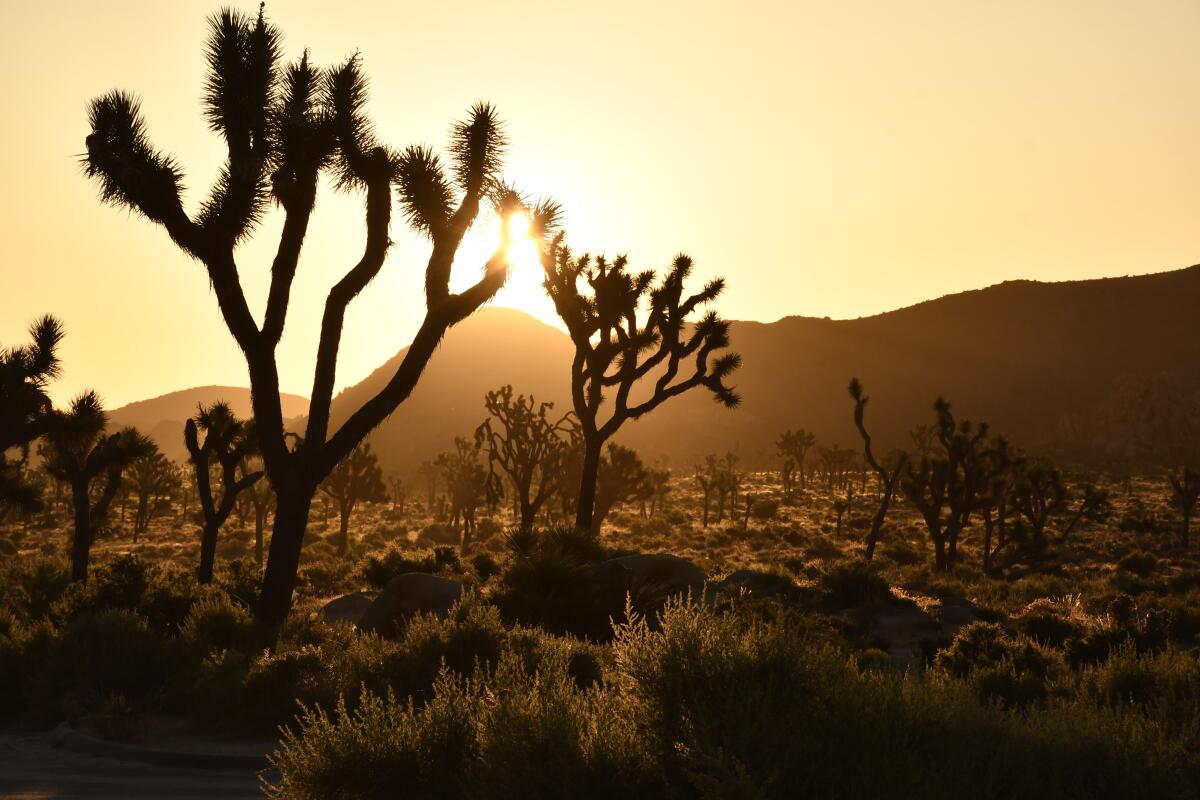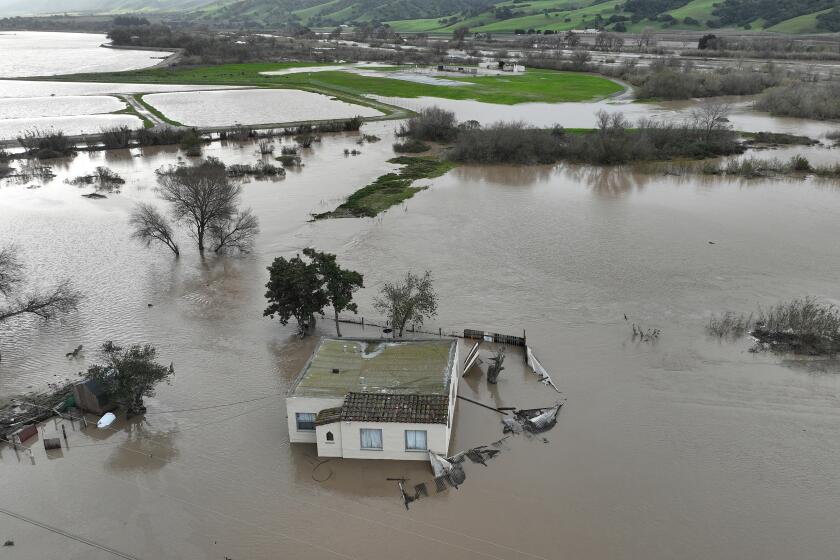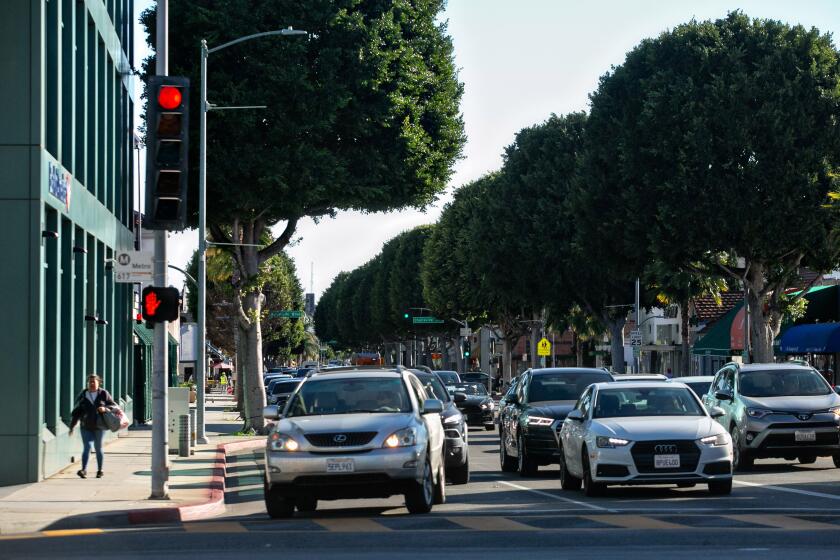Finally, a plan to save Joshua trees from climate change — and the bureaucrats

- Share via
Climate change is the single greatest threat to the long-term survival of the Joshua tree, a beloved symbol of California’s high desert. But the biggest short-term obstacle is an impasse by state wildlife officials, who have been unable to agree whether to list it as threatened under the state Endangered Species Act.
Gov. Gavin Newsom’s administration is proposing a promising solution, legislation that would provide comprehensive protection for the imperiled trees at the center of a battle over competing uses of the Mojave Desert and the interconnected threats of rising temperatures, drought, development and wildfire.
The proposal would protect the trees from being wiped out by the next century while allowing for renewable energy and housing development — no matter what the California Fish and Game Commission decides. It’s a well-thought-out compromise that acknowledges both scientific and political realities, and would still allow designation as threatened, though that move seems unlikely.
Scientists have long warned that climate change poses an existential threat to the western Joshua tree, one of two distinct species that live in California, and that the tree could lose more than 90% of its current habitat by the end of the century without greater protections. But powerful interests oppose listing it as threatened, saying it would put up too many barriers to urban development and solar and wind energy projects that California needs to slash greenhouse gas emissions.
Gov. Gavin Newsom has effectively ended environmental regulations protecting California rivers and migratory fish by extending drought-year waivers.
These trees have been under temporary legal protection since 2020, making it illegal to kill them without special permits. But those safeguards would go away if the Fish and Game Commission decides not to list Joshua trees as threatened, returning authority to issue permits to remove Joshua trees to county sheriffs or county agricultural commissioners.
The governor’s proposal would allow wildlife officials to permit the killing or removal of a western Joshua tree only if certain conditions were met, and would give property owners and developers the option of paying mitigation fees instead. The money would be pooled into a state-controlled conservation fund that could be used for large-scale projects, like the acquisition of land in the tree’s northern range and in higher elevation areas where survival is more likely as the climate continues to warm.
One of the strengths of the proposal is a requirement that the Department of Fish and Wildlife, by 2024, develop a conservation plan to save the species across its range. That proactive approach is fitting for this climate-driven threat, and an improvement on the usual process, where threatened and endangered species aren’t subject to serious action to prevent their extinction until their numbers are already so low that it’s almost too late.
Commentary: Why close the ‘super bloom’? Because we can’t seem to love nature without trampling it
It’s too bad officials have closed off public access to a spectacular bloom of wildflowers. Why can’t we seem to appreciate natural beauty without destroying it?
The legislation was crafted with input from Native American tribes, renewable-energy companies, the construction industry, organized labor and environmentalists, and has the support of the Center for Biological Diversity, the group that in 2019 petitioned to protect the western Joshua tree on climate change grounds, triggering the temporary protection.
Prospects for making those protections permanent seemed to dim last year, when state wildlife scientists recommended against listing the Joshua tree as threatened, despite criticism by independent peer reviewers that the analysis had mischaracterized the science and understated the threat climate change poses. In June, the state Fish and Game Commission deadlocked on whether to designate it as threatened, and has since delayed making a decision.
It’s clear that listing the Joshua tree presents challenges unlike any of the roughly 250 other species protected under the California Endangered Species Act. There are millions of Joshua trees spread across a vast area of the state, and about half the tree’s range is on private land, including in fast-growing communities such as Lancaster and Yucca Valley. State wildlife officials predict that the listing of the Joshua tree would create the single biggest permitting workload in its history, requiring them to weigh in on thousands of projects, from home additions to large-scale solar energy arrays.
Editorial: Beverly Hills is chopping down ficus trees — and replacing them with palms? Bad idea
Beverly Hills wants to replace 87 ficus trees on Robertson Boulevard with crape myrtle and palm trees. The city should at least find new shade trees.
Yes, this legislation would make getting a permit for the removal of Joshua trees easier, cheaper and faster than if they were designated threatened under current law. But this approach is still vastly better than the likely alternative of doing nothing. It includes transparency measures, with annual reviews and public reports detailing the effectiveness of the program and how mitigation fees are being spent. It allows the department to periodically adjust the rules and fees to ensure conservation efforts are working.
California wildlife officials’ inability to move proactively to protect the Joshua tree from the warming climate has been disappointing. But this legislation creatively bypasses that and imagines something better: the rare kind of compromise that could actually provide broader, more effective conservation than the Joshua tree would otherwise receive under the current legal and political process.
State lawmakers should advance this legislation and get California a step closer to ensuring the Joshua tree’s survival.
More to Read
A cure for the common opinion
Get thought-provoking perspectives with our weekly newsletter.
You may occasionally receive promotional content from the Los Angeles Times.












